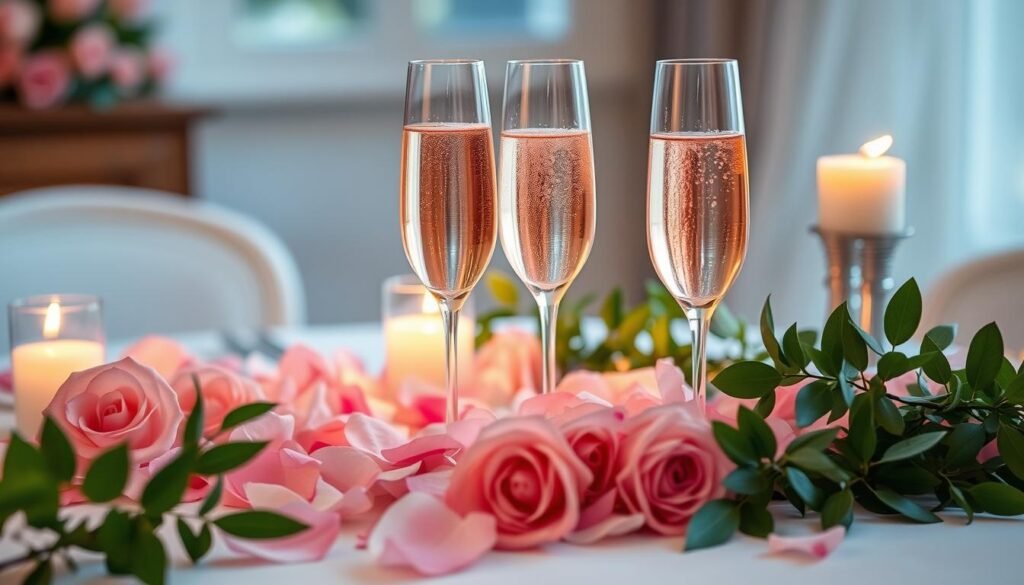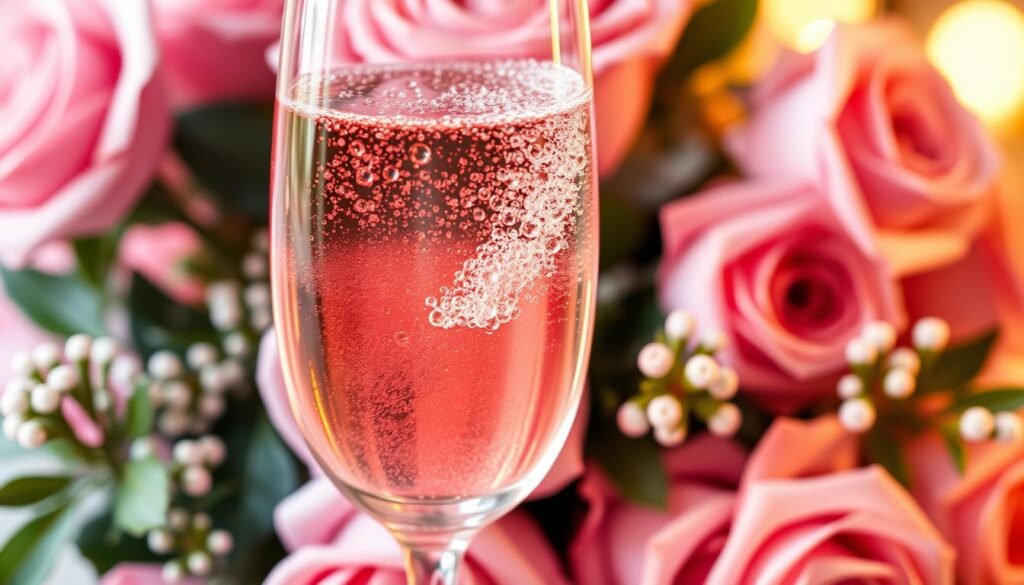Champagne is a symbol of luxury and celebration. This sparkling wine from France’s Champagne region has captivated hearts worldwide. It’s more than a drink; it’s a cultural icon steeped in history.
Rose champagne offers a unique twist with its pink hue. Its vibrant flavors make it perfect for special occasions and everyday indulgence. Let’s explore the essence, production, and serving of this elegant bubbly.
Table of Contents
ToggleKey Takeaways
- Rose champagne is a unique and captivating variation of the iconic French sparkling wine, known for its distinctive pink hue and vibrant flavors.
- The Champagne region in France has a rich history and tradition, with rose champagne being a celebrated expression of the region’s winemaking expertise.
- Rose champagne can be produced using different methods, including the rose de saignée and rose d’assemblage techniques, each imparting unique characteristics.
- Rose champagne is a versatile choice, suitable for celebrations, special occasions, and everyday indulgence, and can be paired with a variety of foods to enhance the dining experience.
- Proper storage and serving temperature are important to maintain the effervescence and optimal flavor profile of rose champagne.
The Essence of Rose Champagne
Rosé champagne’s story sparkles like the drink itself. It began in the Champagne region centuries ago. Monks like Dom Pérignon helped create the techniques behind this beloved bubbly.
The méthode champenoise makes rosé champagne unique. This process involves a second fermentation in the bottle. It’s what creates those signature bubbles we all love.
A Sparkling Introduction
Terroir shapes rosé champagne’s character. This includes the soil and climate where grapes grow. Rosé champagne is known for its pink hue and fruity flavors.
It’s a popular choice for those who enjoy sweet sparkling wine. Its vibrant taste sets it apart from other champagnes.
The Champagne Region and Its History
Northeastern France is home to the Champagne region. It has a long history of making exceptional vintage champagne. This rich heritage has led to the unique style of rosé champagne.
Rosé Champagne: A Captivating Variation
Rosé champagne blends red and white grapes. These are typically Pinot Noir and Chardonnay. Careful cultivation in the Champagne region ensures top quality.
The balance of these grapes creates a refreshing drink. Combined with the méthode champenoise, it results in an indulgent rosé champagne.
“Rosé champagne is a captivating variation, known for its pink hue and vibrant, fruity flavors, making it a popular choice for those who enjoy a touch of sweetness in their sparkling wine.”
The Art of Creating Rose Champagne
Rosé champagne production uses two main methods: rosé de saignée and rosé d’assemblage. Each method creates a unique bubbly, showing off the winemaker’s skill. These methods highlight the special qualities of the Champagne region.
Rosé de Saignée Method
The rosé de saignée method mixes grape juice with grape skins. This process uses Pinot Noir and Pinot Meunier grapes to create the pink color. Skilled handling is key, as skin contact time affects the champagne’s color and taste.
Rosé d’Assemblage Method
The rosé d’assemblage method blends red and white wines. This creates a balance of flavors and color. Winemakers can adjust the red-to-white ratio to get the desired result.
The chosen method greatly impacts the champagne’s taste and look. Each bottle reflects the winemaker’s craft and the region’s unique qualities.
| Champagne Production Methods | Rosé de Saignée | Rosé d’Assemblage |
|---|---|---|
| Process | Maceration of grape skins in the juice | Blending of red and white wines |
| Color | Deeper, more intense pink hues | Lighter, more delicate pink shades |
| Flavor Profile | Pronounced red fruit flavors | Harmonious blend of red and white grape characteristics |
| Complexity | More complex and nuanced | Typically more straightforward |
Both methods create captivating rosé champagne. This bubbly showcases the Champagne region’s excellent winemaking skills. It remains a sought-after drink for champagne lovers worldwide.
Rose Champagne for Celebrations
Rose champagne is a special sparkling wine perfect for grand celebrations and intimate moments. Its vibrant color, fruity notes, and festive bubbles make it ideal for joyous occasions. From weddings to personal triumphs, rose champagne adds a touch of elegance.
This bubbly drink can transform any gathering into a memorable experience. It evokes a sense of luxury, success, and pure joy. Rose champagne is a favorite among those who appreciate life’s finer things.
The blush-hued sparkle and captivating aromas elevate simple gatherings into unforgettable special occasions. Its versatility allows it to fit both grand ballrooms and intimate dinner parties. Rose champagne is essential for any celebration calling for luxury and opulence.
“Rosé Champagne constituted around 18% of Champagne exports to the United States in recent years, a significant increase from being under three percent two decades ago.”
The demand for rose champagne continues to grow. It has become a symbol of refined joy and indulgence. Rose champagne is perfect for adding sparkle and sophistication to special occasions.
Decoding the Rose Champagne Label
Understanding a rose champagne label helps you pick the perfect bubbly. Each element on the label offers valuable insights. Let’s explore what these details mean for your champagne selection.
Producer Name and Champagne Type
The producer name is usually the most prominent text on the label. It tells you who made the champagne. This could be a famous house like Telmont or a smaller winery.
The champagne type reveals its style and taste profile. It might be Brut, Rosé, or Vintage. This info helps you know what to expect.
Region, Vintage, and Designations
True rose champagne must come from the Champagne region of France. This origin is a mark of quality and authenticity. The vintage, if shown, tells you when the grapes were picked.
Special labels like “Réserve” or “Extra Brut” give hints about the champagne’s traits. These clues help you choose the right bottle for your celebration.
“Champagne labels underwent significant defensive measures culminating in the granting of a controlled designation of origin (AOC) in 1936.”
Knowing these label details helps you make smart champagne choices. You can now pick a bubbly that fits your taste and occasion perfectly.
Prestige Cuvee Rose Champagnes
Prestigious cuvée releases stand at the pinnacle of rosé champagne. These rare prestige cuvée rosé champagnes showcase exceptional grape quality and winemaking skill. They result from outstanding vineyard years and meticulous craftsmanship.
The Ruinart Brut Rosé exemplifies this category with its exquisite balance. Prestige cuvées often age longer, developing complex aromas and flavors. These bottles captivate the senses with their depth.
Prestige cuvée rosé champagnes are prized for their exclusivity. They’re perfect for special occasions or as gifts for champagne connoisseurs. These masterpieces embody the essence of luxury in sparkling wine.
“Prestige cuvée rosé champagnes are the pinnacle of sparkling wine, showcasing the culmination of the winemaker’s craft and the region’s finest vineyards.”
These champagnes offer an unmatched sensory journey. They leave lasting impressions on both palate and memory. Savoring them celebrates life’s precious moments in style.
Food Pairings: Elevating the Rosé Experience
Rose champagne pairs well with various foods, enhancing any meal. Its fruity notes and vibrant color complement many cuisines. The right pairings can turn a simple meal into an unforgettable experience.
Ideal Pairings for Rose Champagne
Dry Brut rose champagne, like Ployez-Jacquemart Extra Brut Rosé, goes well with light appetizers and seafood. Its bubbles and acidity balance rich dishes perfectly. Grilled Shrimp Skewers and Smoked Salmon Canapés are excellent choices.
For romantic evenings, rose champagne pairs nicely with desserts, soft cheeses, and fresh berries. Strawberry Shortcake and Lemon Sorbet complement the wine’s subtle sweetness beautifully.
Tips for Serving Rose Champagne
Serve rose champagne chilled, between 40-45°F, to fully enjoy its flavors. Use tulip-shaped or coupe glasses to appreciate the wine’s aromas.

Pairing rose champagne with the right dishes creates a memorable dining experience. Its color, fruity notes, and bubbles make it perfect for food lovers.
Rose Champagne: A Versatile Choice
Rose champagne can elevate any occasion, from grand celebrations to quiet moments of indulgence. Its style can be tailored to suit your preferences and the event’s mood. Whether you’re toasting at a wedding or enjoying a romantic evening, rose champagne fits the bill.
Those who like sweetness might enjoy a Rosé champagne, like Graham Beck Bliss Nectar Rosé. For connoisseurs, a Vintage rose offers a unique experience capturing a particular year’s harvest essence.
Rose champagne stands out in the world of sparkling wines. Its versatility caters to a wide range of personal preferences. From celebrations to everyday enjoyment, it enhances any moment.
“Rose champagne is the only type of champagne that allows the blending of red and white wine, often incorporating Pinot Noir, Pinot Meunier, and Chardonnay grapes.”
Champagne Rosé is typically produced through the ‘saignée’ method. This unique process sets it apart from other rosé wines. The Champagne region’s cool climate and chalky soil contribute to its captivating character.
Rose champagne offers something for everyone, from sweet to complex flavors. It can enhance any gathering, big or small. This sparkling delight truly stands out in the champagne world.
Storing and Serving Rose Champagne
Proper storage and serving are key for the best rose champagne experience. Store it in a cool, dark place away from sunlight. The ideal storage temperature is around 55°F for slow aging and flavor development.
Chill rose champagne to 45-50°F before serving. This enhances its aromas and crisp character. Opened bottles can stay fresh for 3-5 days if refrigerated with a hermetic cork.
Vintage rose champagnes can age up to 20 years. Non-vintage varieties are best enjoyed within months of purchase. Choose flute or tulip-shaped glasses to showcase bubbles and color.

The Comité Interprofessionnel du Vin de Champagne recommends tulip-shaped glasses. These maintain the champagne’s effervescence best. Proper storage, temperature, and glassware elevate your rose champagne experience.
Conclusion
Rose champagne captivates wine lovers with its vibrant hue and fruity flavors. This sparkling wine elevates any occasion, from grand celebrations to quiet moments. Our guide explored rose champagne’s history, production methods, and pairing techniques.
Rose champagne transforms ordinary moments into extraordinary experiences. It showcases the art of winemaking and the power of luxury. Each sip promises to transport you to a realm of bubbly bliss.
This wine celebrates the senses, blending tradition and innovation. Its versatility shines when paired with decadent desserts or summer dishes. Rose champagne suits both seasoned enthusiasts and newcomers to sparkling wines.
FAQ
What is rose champagne?
Rose champagne is a unique variation of classic champagne. It’s known for its pink hue and fruity flavors. This sparkling wine comes from the Champagne region in France.
How is rose champagne made?
Rose champagne is made using two main methods. The rosé de saignée method involves macerating grape juice with skins. The rosé d’assemblage method blends red and white wine for desired color and flavor.
What are the different styles of rose champagne?
Rose champagne comes in various styles like Brut, Rosé, and Vintage. The label usually indicates the style. It provides info about sweetness level and harvest year.
What makes rose champagne unique?
Rose champagne’s character comes from the Champagne region’s terroir and winemaking techniques. It uses grape varieties like Pinot Noir, Pinot Meunier, and Chardonnay. The result is a vibrant pink wine with fruity, elegant flavors.
How should rose champagne be stored and served?
Store rose champagne in a cool, dark place to preserve its flavors. Serve it chilled between 45-50°F. Use flute or tulip-shaped glasses to showcase its bubbles and color.
What are the best food pairings for rose champagne?
Rose champagne pairs well with many foods. It goes great with light appetizers, seafood, desserts, and soft cheeses. Its fruity notes make it perfect for celebrations and romantic occasions.
What are prestige cuvée rose champagnes?
Prestige cuvée rose champagnes are the finest in rose champagne production. They’re crafted with exceptional care and attention to detail. These rare champagnes come from exceptional vineyard years and often undergo extended aging.

